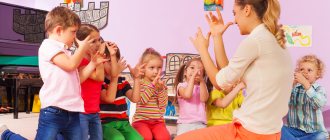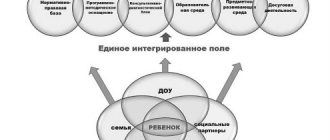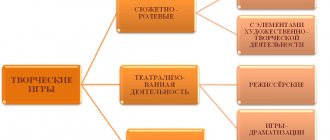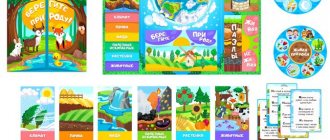Lapbook as an original innovative guide, beautiful and useful
The author of the manual is considered to be American Tammy Dubey. She came up with the idea of filling a small folder with a variety of pictures, pockets, rhymes, and paper crafts to reinforce and preserve the information she had learned with her children. Photos of the first lapbooks found their way onto the Internet and this manual became the property of all concerned parents, educators and teachers. Lapbooking (production of lapbooks) is recognized as an innovative technology with many advantages.
The very name of the manual is translated from English either as a “knee book” or as a “folding book”, and both options are completely fair. Lapbooks are small in size (usually A4 format when folded) and it is convenient for a child to look at them while holding them on his lap. In addition, these wonderful books are full of riddles and secrets, they fold out and have many pockets, inserts, notepads, which in turn open, which is very much to the taste of little researchers and lovers of secrets.
Studying a laptop begins with looking at all the treasures hidden in it.
What game elements are included in the layout and why?
Lapbooks for preschoolers are distinguished by a greater (compared to school) presence of game elements. These are rotating circles, opening windows, moving parts and figures. The first impression of a lapbook is usually for both children and adults: it’s fun, entertaining. But this is how it should be, because preschool children learn about the world through play. The first two or three lessons with a laptop will definitely be devoted to studying its wonderful properties and capabilities as a toy, and only after that the kids will be able to comprehend the useful information contained in it. There is no point in rushing children; their involuntary memory and attention are very developed, and unnoticed by themselves, by manipulating with pockets, circles and pictures, they will learn a fairly extensive amount of information.
It is thanks to such unusual elements that kids really like lapbooks.
Benefits for preschoolers and teachers
Two significant features of the laptop should be noted:
- Interactivity. The child interacts with the folder, rather than just looking at it. Active participation greatly increases interest in the benefit. This is especially important for kinesthetic children (with a predominance of the sense of touch as a means of understanding the world around them), because it is no secret that in the modern educational process visual methods predominate (demonstration of illustrations, videos and slides), as well as the use of music and audio recordings.
- Thematic. It is difficult to collect information on different topics in a small folder; it will be difficult for children to assimilate and understand it, so lapbooks are usually dedicated to one topic, for example, “Autumn”, “Birds”, “Family”. In the older group, which involves a more in-depth study of certain topics, it is possible to cover a more specific subtopic in the lapbook: “Gifts of Autumn”, “Wintering Birds”, “Family Holidays”.
Thus, a modern lapbook is a thematic interactive folder (book) containing systematized and variously designed information.
Usually the title page of a folder already announces its topic.
The purposes for using lapbooks are also very diverse. This includes consolidating everything that children have learned during the project, learning to collect and systematize information, developing creativity and creativity, and fostering a caring attitude towards a product made collectively, and respect for common work. One of the most important objectives of the manual is considered to be the stimulation of cognitive activity in children, the desire to learn and remember new things, and in older preschool age, the awakening of the desire to learn.
Lapbook as an element of a developing subject-spatial environment in a preschool educational institution
We all know that things that are interesting are remembered better. How can we make sure that the material covered remains in the child’s memory, so that he wants to independently expand his horizons on this issue? I present to your attention a teaching aid - a lapbook, as one of the ways to achieve this goal. What is a lapbook? A laptop, or as it is also called a thematic or interactive folder, is a homemade paper book with pockets, windows, and movable parts. A laptop is a new form of organizing educational activities for the development of children’s cognitive activity and the development of independence. It collects material on a specific topic . A laptop is not just a folder , but a visual and practical teaching method that meets modern requirements for organizing a subject-spatial developmental environment in the context of the implementation of the federal state educational standard for preschool education:
- transformability (makes it possible to change the space depending on the educational situation);
- multifunctionality (use in different types of children's activities );
- variability (periodic replacement of various materials, ensuring free choice of children);
- the availability of a lapbook provides all types of children's activities ;
- The lapbook meets the most important requirement for organizing a PPRS - safety.
What is the importance of a lapbook for a teacher ? It facilitates the organization of material on the topic under study within the framework of comprehensive thematic planning; contributes to the formalization of the results of joint project activities; promotes the organization of individual and independent work with children. For a child , a lapbook is an assistant in :
- understanding and remembering information on the topic being studied;
- the child acquiring the skills to independently collect and organize information on the topic being studied;
- repetition and consolidation of material on the covered topic.
A laptop is a great way to reinforce a certain topic with children, comprehend the contents of a book, and conduct research work, during which the child participates in searching, analyzing and sorting information. As you already know, there is a lot of preparation going on for the Victory Day celebrations, a lot needs to be done, that’s why I decided to create a lapbook in the group.
On the eve of the celebration of Victory Day and as part of the implementation of the plan for working with children, I chose the theme for the laptop “Victory Day”. Goal: To develop civic and patriotic feelings in preschool children, a sense of pride in the feat of their people in the Great Patriotic War.
Tasks:
- To develop children’s cognitive abilities in the process of practical activities, the child’s intelligence, to form visual and figurative thinking, creativity, independence, and relationship skills with adults;
- Enrich the active vocabulary with new words, encourage children to retell stories they heard at home about loved ones, showing their photographs;
- Provide an atmosphere of goodwill, comfort in communication: parent-parent; parent-teacher; parent – child;
- Organize activities for children and parents aimed at collecting information on the topic.
- Cause an emotional response to the result of your activities.
Introspection
Why did I choose the form - lapbook? On the laptop I placed stories about child heroes of the Second World War; poems, riddles, coloring books, wartime professions, wartime technology, by looking at a picture, children learn to make sentences. And this solved several problems at once:
- convey to children information about the celebration of Victory Day;
- expand knowledge about the Second World War, about the heroes of the Second World War, about the victory of our country in the war;
- tell children about the child heroes of the Second World War;
- cultivate a sense of pride in the country that won the Second World War against Nazi Germany;
- to cultivate patriotism and love for the Motherland in children.
It helps the child to organize information on the topic being studied at will, to better understand and remember the material. This is an excellent way to review what you have learned and will help consolidate and systematize the material you have studied. Children learn to independently collect information and use it. The laptop is well suited for individual and group lessons. Suitable for repeated use. You can choose tasks that each child can do (for some, choose poems or prepare cards, and for others, make a book). The theme of the lapbook can be anything, as well as its complexity. A laptop can be considered as part of the subject-development environment in a preschool educational institution. It meets the requirements of the Federal State Educational Standard for Educational Education for a subject-development environment:
- Informative;
- Multifunctional: promotes the development of creativity and imagination;
- Suitable for use by a group of children at the same time (including with the participation of an adult as a playing partner);
- Has didactic properties;
- It is a means of artistic and aesthetic development of the child, introducing him to the world of art;
- Variability (there are several options for using each part);
- Its structure and content are accessible to preschool children;
- Provides playful, educational, research and creative activity for all pupils.
Such an unusual presentation of material always attracts the child’s attention, and he returns to this folder more than once to look through it, play with it, and at the same time, unbeknownst to himself, repeat the material he has covered.
Thus, in the course of working with this manual, I have implemented and continue to implement several tasks:
- I am developing myself as a professional;
- managed to introduce fellow teachers to a new type of learning and development of children;
- The children and parents were interested; this form of organizing activities made it possible to raise work with parents to a higher level.
Types of lapbooks
Thematic folders come in several types. They are mainly distinguished by the method of application.
Types of benefits depending on purpose and content
It is customary to distinguish the following types of laptops according to their purpose:
- Gaming . This folder is intended for play, together with a teacher or for an independent child, so the main emphasis in it must be on entertainment and ease of perception of information. In addition to movable game elements (windows, circles, sliding pockets-petals), you can put into it the now popular walking games, cards for logic games like “Who am I?”, “What did I wish for?”, small items for the game “What” in my hand?”, “Guess by touch” in a small fabric bag.
- Educational (encyclopedic) . An excellent tool for organized educational activities and individual work to consolidate a specific topic. In such a lapbook you can place not only educational games, memory cards, proverbs, but also interesting facts, folk signs, and quiz questions. Naturally, children will be able to use such a benefit with the help of a teacher.
- Congratulatory . It will be an original and very pleasant gift for a loved one whose tastes and hobbies you know well. A daughter’s best friend would like a lapbook made together with her mother, in which there is room for shared photographs of the girlfriends, a paper doll with a set of dresses and accessories, a hand-sewn rag doll, and a small flat box with children’s jewelry. A lapbook as a gift for a boy can be filled with magnets with images of dinosaurs, cartoon characters, a wooden construction set (its parts are flat and will fit in an envelope), photographs of your favorite athletes, cars.
- Autobiographical . This can be either the story of one child (the parents help the child make the materials and design at home), or the life story of one kindergarten group, which will contain photos, crafts and funny sayings of the kids. When making the “Our Group” lapbook, it is important to distribute the material so that each child receives attention, each is present in some section and in at least one of the photographs.
This New Year's lapbook will be a wonderful gift for the whole family.
Differences in lapbooks depending on the age of children
Equally important is the division of lapbooks according to the age of the children. Thematic folders for primary preschool age are distinguished by a smaller number of pages, interactive elements, more general coverage of information, and large details.
Experts who use lapbooks in depth recommend their use in working with children aged five years and older, but even at a younger age, under the supervision of a teacher, children can work with a lapbook and learn how to put things in order (fold pictures into envelopes, fold and close petals “secrets”, etc.). Folders for the development of color perception in combination with tactile perception (with elements made of multi-colored felt, fabric, fur, burlap) will be useful at this age.
A laptop for little ones has large elements and a minimum of tasks.
For fidgety four-year-olds of the middle group, folders with a large number of moving elements, puzzles, and simple logic problems (“Find a pair,” “What’s extra?”) are suitable. This simultaneously helps to develop children and satisfy their natural curiosity at this age.
Children of the middle group will enthusiastically consolidate their knowledge about fruits and vegetables by placing pictures in the right baskets
Older preschoolers show not only interest in the entertainment possibilities of a lapbook, but also inquisitiveness and consistency in mastering the knowledge contained in it. They are interested in both looking at the image and learning new information about it. Therefore, in pictures in folders, you can place short texts with educational information on the back. Children often ask the teacher to read them, memorize them and retell them to their friends.
The development of thinking and improved memory of children of the sixth or seventh year of life justifies the complication of the material presented. Older preschoolers have access to the games “Remember the Proverb”, “Read the Poem”, “Words-Relatives”, in which it is necessary to reproduce a certain text from a picture. Children of this age are also interested in logical games “What comes first, what comes next”, “Put the pictures in order”, “Part and whole”, “Opposites”. They are placed in a laptop, selecting images in accordance with the theme.
The folder for older preschool age contains much more text information and related tasks
Materials and shape of the interactive folder
The material from which lapbooks are made can be very diverse, the main thing is that it is approved for use in preschool institutions. For this reason, it is better not to use some types of building materials (ceiling tiles, finishing plastic), because inexpensive types of them may be of poor quality, and those that meet the standards “bite” in price. Therefore, it is better to focus on familiar, safe materials: cardboard, whatman paper, colored paper. Cardboard boxes for sweets, cookies, ready-made A4 folders, folders for manual labor, where additional sheets are glued, are also suitable for the base.
The shapes of lapbooks depend on the imagination of their creators:
- Classic rectangular;
- Square, oval, in the form of other geometric shapes;
- Reflecting the theme of the folder, that is, in the form of a nesting doll, a cup, a bird, a flower, a cloud.
When choosing a shaped option, you should remember that the lapbook will be used often, and too small, thin parts, for example, the spout of a teapot or the stem of a flower, may simply fall off.
Recently, a “lapbox” manual has appeared, that is, a “folding box”. It is distinguished by its design, in which parts of the product are folded into a box and secured with tape or fasteners. When the fastening is removed, the laptop “disintegrates”, revealing the contents of the walls, that is, the same envelopes, notebooks, and other elements. This impressive manual is suitable for games and gifts, but is still little used as a teaching tool.
Video: playing with lapbox in a kindergarten group
Lapbooks in the form of books with a small number of pages, folders with inserts and accordion screens have taken root in kindergartens. It is difficult for children to hold the latter on their laps; they are used on a table or rug.
Photo gallery: types of lapbooks used by kindergarten teachers
A traditional version of a lapbook from a ready-made stationery folder with inserts
This lapbook will help young mathematicians navigate the world of numbers and figures.
An original version of a lapbook with knitted elements from handicraft educators
You can't do without letters in a literacy lapbook
A butterfly-shaped folder will teach kids about these wonderful insects.
An ecology laptop will teach kids how to sort garbage
The interactive folder about the ladybug looks elegant and is filled with interesting tasks
MAGAZINE Preschooler.RF
Pedagogical article “Use of a laptop in the educational process of MBDOU”- Babenkova Natalya Viktorovna teacher, MBDOU d/s No. 89, Belgorod
- Avdeeva Marina Ivanovna Soc. teacher MBDOU d/s No. 89, Belgorod
Currently, the concept of “innovation” . Today, innovative phenomena are found in all elements of the pedagogical process, including education and upbringing. Innovations are aimed at creating a basic personal culture, comprehensive development of personal qualities in accordance with age and individual characteristics, and preparing a child for life in modern society. These processes have a positive effect on the quality of education and upbringing in educational institutions, increase the professional level of teachers, create better conditions for the spiritual development of children, and, most importantly, allow for a person-oriented approach to each child.
One of the innovative ways to organize educational activities with preschoolers is a lapbook.
A lapbook, or as it is also called a thematic or interactive folder, is a homemade paper book with pockets, doors, windows, and movable parts that a child can take out, rearrange, and fold at his discretion. It collects material on a specific topic. At the same time, a lapbook is not just a craft. This is the final stage of independent research work that the child has done while studying this topic. To fill out this folder, the child will need to complete certain tasks, make observations, and study the material presented. Creating a lapbook will help consolidate and systematize the material studied, and looking at the folder in the future will allow you to quickly refresh your memory of the topics covered. A laptop will allow you to gain social experience and form a positive attitude towards basic social values.
Depending on the purpose, laptops can be:
- educational;
- gaming;
- congratulatory, holiday;
- autobiographical (a folder-report about some important event in a child’s life: travel, going to a museum, etc.)
They can also vary in shape:
- standard book with two spreads;
- folder with 3-5 spreads;
- accordion book;
- curly folder.
The content of summer books can be varied:
- standard pockets;
- regular and figured envelopes;
- accordion pockets;
- book pockets;
- windows and doors;
- rotating parts;
- protruding parts;
- cards; tags; arrows;
- puzzles;
- blank sheets for notes
Why did this form of work in a preschool educational institution become attractive to us?
Firstly, a lapbook helps a child organize information on a topic of interest at will, and better understand and remember the material.
Secondly, this is a great way to review the material you have covered. At any convenient time, the child simply opens the laptop and happily repeats what he has learned, looking at the book he made with his own hands.
Thirdly, the child independently collects and organizes information.
Fourthly, you can choose tasks that everyone can do (for kids - pockets with cards or animal figures, for example, and for older children - tasks that require the ability to write, etc.)
In the process of such creativity, the child becomes not only the creator of his own book, but also a designer, illustrator, and writer of his own stories, riddles, and poems. This exciting form of work creates conditions for the development of the child’s personality, motivation and abilities.
A laptop is a game, creativity, learning and exploring new things, repeating and consolidating what has been learned, systematizing knowledge and simply an interesting type of joint activity between a teacher, parents and a child..
| Next > |
Stages of making a “knee book” (step by step)
If a lapbook is the final stage of a project activity, then it is made simply: take a capacious folder, collect all the materials accumulated during the project (drawings, task cards, children’s flat products) and place them in appropriately sized pockets. Next, children can use the folder to remember their participation in the project and discuss their impressions of it.
But making a laptop can also become a separate project, in which case careful and painstaking preparation is required. It consists of the following points:
- You need to decide on a topic. At younger and middle ages, traditional topics are taken, such as “Seasons”, “Wild and Domestic Animals”, “Vegetables and Fruits”, “Transport”, “Professions”. Older preschoolers will be interested in “Animals of hot countries”, “Space exploration”, “Amazing things in the natural world”, “Protecting our planet”. Together with your parents, you can make folders “Horoscope of our group”, “We work”, “Holidays of our group”, “What is school”, “Professions of our mothers and fathers”, “Ecological kaleidoscope”, etc.
- Drawing up a plan, according to the points of which information on the topic will be searched.
- Making a layout, this also includes choosing the design of individual parts of the laptop. Children and adults discuss what information is best presented in the form of a book, rotating circles, drop-down pockets, windows, and other things. The layout is sketched, and in the future the production of the folder will be based on it.
The layout can be as simple as possible and drawn on a sheet of plain white paper
- Studying the topic, searching for information. Adults should teach the child how to collect information from different sources (books, magazines, excursions, observations). You can organize a trip to a museum or library. If a child owns a computer, he can search for some information on the Internet together with his parents. Do not allow the Internet to become the only source of information - this will significantly narrow your child’s horizons and negatively affect his communication abilities.
Even parents of students can be captivated by making a laptop





